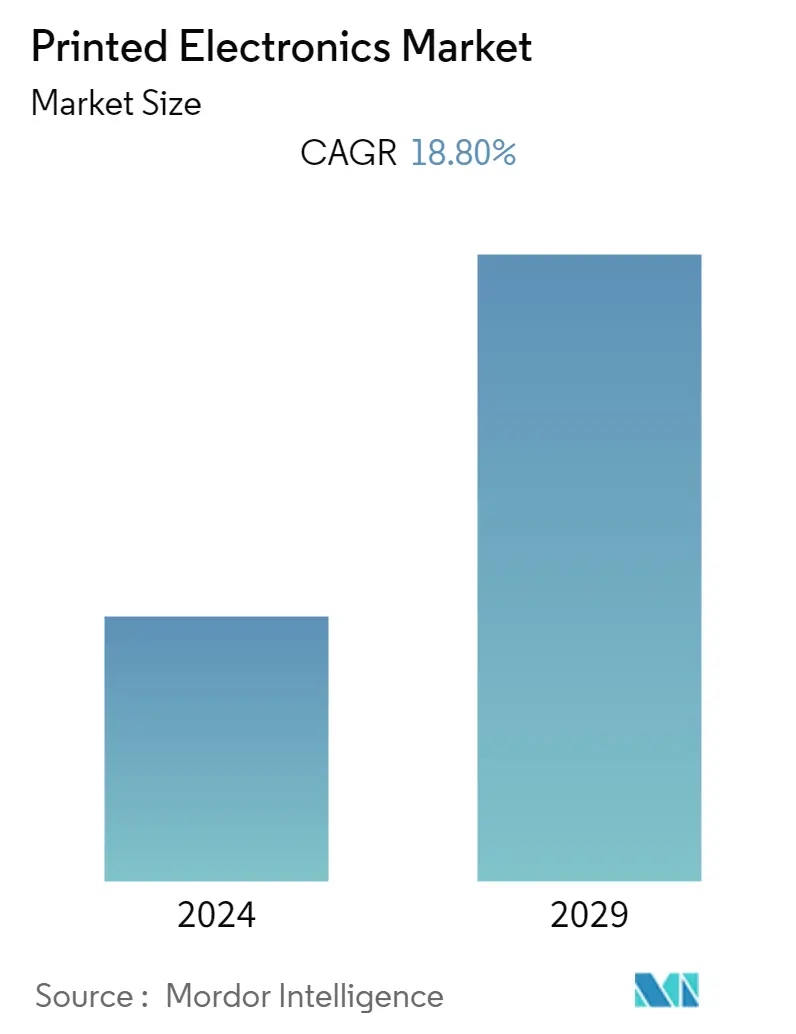Market Size of Printed Electronics Industry

| Study Period | 2019 - 2029 |
| Base Year For Estimation | 2023 |
| CAGR | 18.80 % |
| Fastest Growing Market | Asia Pacific |
| Largest Market | North America |
| Market Concentration | High |
Major Players.webp)
*Disclaimer: Major Players sorted in no particular order |
Need a report that reflects how COVID-19 has impacted this market and its growth?
Printed Electronics Market Analysis
The printed electronics market in the healthcare industry is anticipated to witness a CAGR of 18.8% over the forecast period.
- The low cost of manufacturing, the evolvement of digital print technology, the rise in funding activity, and the healthcare industry's inclination towards newer technologies are the factors responsible for the growth of the printed electronics market in the healthcare industry.
- Printed electronics offer photonic and printed electronics on various substrates; some widely used printing technologies include flexography, inkjet, gravure, and screen printing. These techniques print on substrates such as cloth, paper, and plastics. This printing method is widely used on wearable devices, sensors, and flexible screens.
- The healthcare sector has profited significantly from the latest developments in materials for printed electronics, ranging from integrated Nanoscale sensors, electronics, and microfluidics to sophisticated synthetics. Moreover, innovations and high consumer adoption have led to the development of more stretchable, flexible, and conformal biosensors for medical monitoring, diagnostics, and drug delivery.
- The use of printed electronics technology has been proven to be significantly beneficial in enabling remote patient monitoring as the healthcare providers can leverage easy-to-use and affordable devices such as wearables and printed sensors to keep track of the patient remotely, resulting in reduced unnecessary visits, optimized time with patients, and improved communication. Cost is another significant benefit. According to Henkel, printed electronics are projected to save USD 200 billion over the next 25 years.
- In the long run, the costs are anticipated to decline owing to the growing competition and emerging presence of multiple players. Digital transformation and an inclination toward newer technologies in the healthcare industry fuel this. Countries worldwide are willing to increase their healthcare expenditure to revolutionize patient care.
- However, the medical industry is highly regulated, considering the high stakes involved; hence, any new technology has to undergo several regulatory checks and satisfy quality requirements before getting into mass production, which is among the significant factors challenging the studied market'smarket's growth. Furthermore, the lack of standardization across geographies also challenges the development of the studied market.
- COVID-19 had a considerable impact on the growth of the studied market. A sudden rise in the number of patients, especially during the initial phase, increased the burden on healthcare facilities, encouraging them to invest in advanced digital technologies. Furthermore, the penetration of personal health tracking devices also increased during the pandemic. Although the impact of the pandemic is reducing, such trends are expected to sustain during the forecast period, creating growth opportunities for the studied market.
